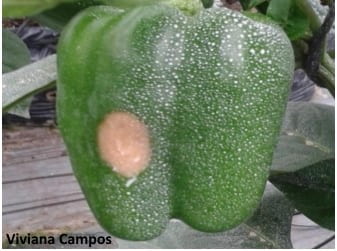Jul 27, 2020Using particle films for sunburn protection
With the recent high temperatures, we have seen an increase of sunburn in vegetables and fruits. Crops with inadequate leaf cover will be most susceptible.
For sunburn protection at a field scale, use of film spray-on materials can reduce or eliminate sunburn. These materials are kaolin clay based, calcium carbonate (lime) based, or talc based and leave a white particle film on the fruit (such as Surround, Screen Duo, Purshade, Reflections and many others). There are also film products that protect fruits from sunburn but do not leave a white residue, such as Raynox. Apply these materials at the manufacturer’s rates on the label for sunburn protection. They may have to be reapplied after heavy rains or multiple overhead irrigation events.
Particle films also have been used to reduce heat stress related disorders in fruits and vegetables. While particle films have gained use in tree fruits, their usefulness in vegetables is still unclear. Research in a number of states has shown reduced fruit disorders such as sunburn in peppers and white tissue in tomatoes when applied over those crops. Watermelon growers have used clay and lime based products for many years to reduce sunburn in that crop in southern states. Research at the University of Delaware in 2018-2019 showed improved tomato interior quality with some particle film products. Past work on watermelons has shown limited usefulness for overall stress avoidance.
There are some drawbacks to the use of particle films. If used for sunburn protection on fruits, there is added cost to wash or brush the material off at harvest. Where overhead irrigation is used, or during rainy weather, the material can be partially washed off of plants, reducing effectiveness and requiring additional applications. Produce buyers can also have standards relating to the use or particle films and may not accept products with visible residues.
– Gordon Johnson, Extension Vegetable & Fruit Specialist, University of Delaware
Purshade treated pepper. Note the sunburn on the side with lower coverage. Photo: Vigiana Campos















